
The fight for the Senate starts off with only a handful of seats at risk. And that’s being generous.
A few other states are worth your attention because of their competitiveness or questions about President Donald Trump’s impact, but almost two-thirds of Senate contests this cycle start as “safe” for the incumbent party and are likely to remain that way.
Of course, a retirement or a public scandal could create a contest where one should not exist, and an implosion of the Trump presidency could create an opportunity or two for Democrats.
But the nation’s polarization and intense partisan divide, combined with the fundamentals of the 34 states that will have a Senate race next year, suggest that only a few states — and a few voters — will decide which party runs the chamber in 2021.
The Senate now stands at 53 Republicans and 47 in the Democratic Conference. So Democrats need a net gain of three or four seats to win control, depending on who wins the White House (since the vice president, as president of the Senate, casts tie-breaking votes).
Seven of the dozen Democratic seats up this cycle are in strongly Democratic states and not competitive: Delaware, Illinois, Massachusetts, New Jersey, New Mexico, Oregon and Rhode Island. Even Sen. Tom Udall’s retirement does not put New Mexico into play.
Among battleground states with Democratic incumbents, Virginia has been moving toward the Democrats as the Washington, D.C., and Richmond suburbs have grown. And Hillary Clinton’s 5-point victory in the state in 2016, combined with the following year’s gubernatorial result, suggests Trump is likely to be an albatross around the neck of the eventual GOP Senate nominee in the Old Dominion.
Minnesota and New Hampshire are competitive states that Democrats cannot afford to lose. (Clinton carried each narrowly.) Both states bear watching, though Democratic incumbents Tina Smith of Minnesota and Jeanne Shaheen of New Hampshire start off with clear advantages.
In Michigan, a state surprisingly carried by Trump in 2016, freshman Democrat Gary Peters starts off with the advantage but must also prove his mettle. Again, his seat is a “must hold” for Democrats.
On the GOP side, 15 of the party’s 22 seats up next year are in states Trump won handily in 2016.
All are both Republican enough and conservative enough to not likely be competitive next year: Alaska, Arkansas, Idaho, Kansas, Kentucky, Louisiana, Mississippi, Montana, Nebraska, Oklahoma, South Carolina, South Dakota, Tennessee, West Virginia and Wyoming.
The Eight Key Races
That leaves eight Senate races for 2020 worth mentioning — two in states won by Clinton (Colorado and Maine) and six in states that backed Trump (Alabama, Arizona, Georgia, Iowa, North Carolina and Texas).
Alabama, won by Trump by 28 points in 2016, is all but lost for Democrats.
Alabama Republicans would have to nominate Judge Roy Moore again to have any chance of...

